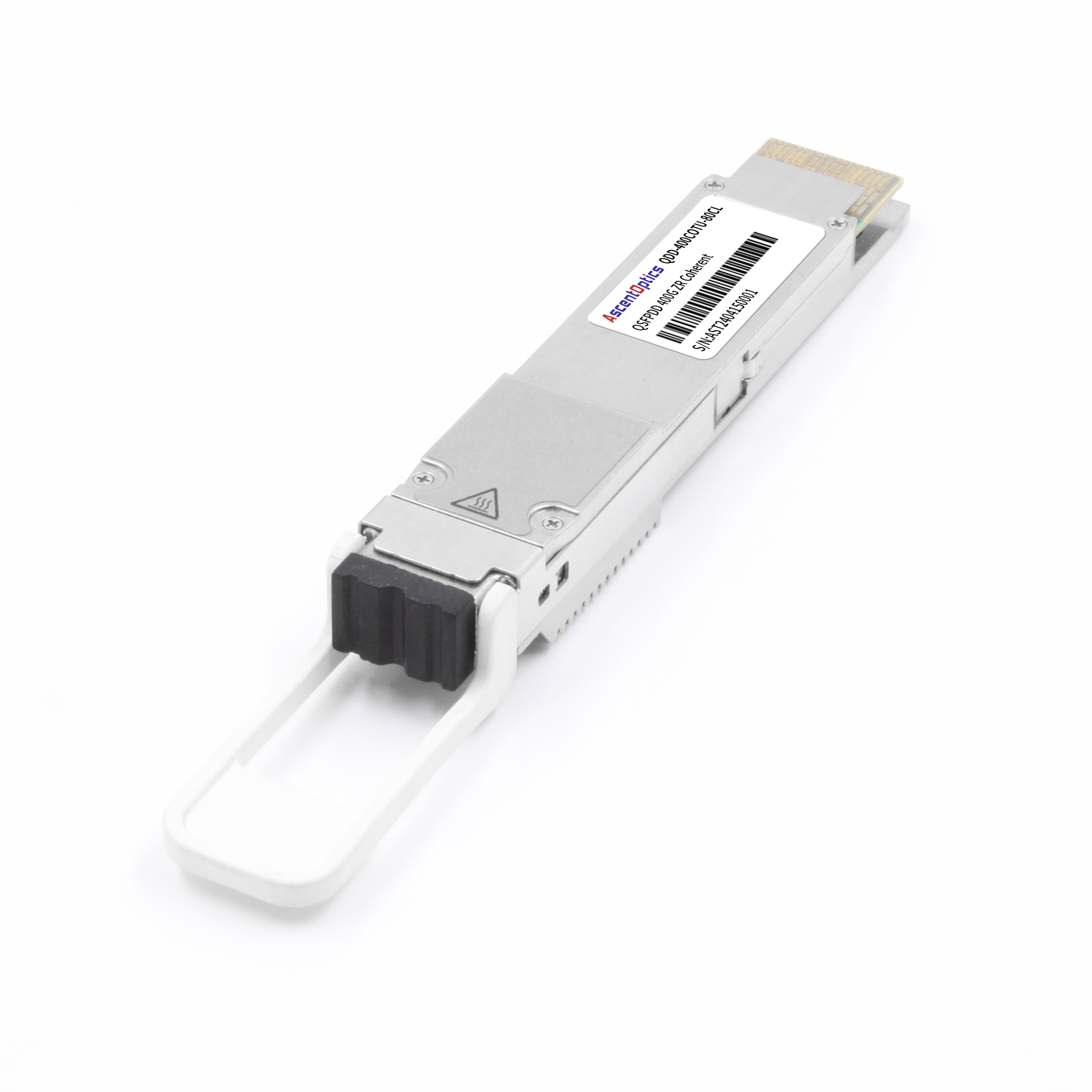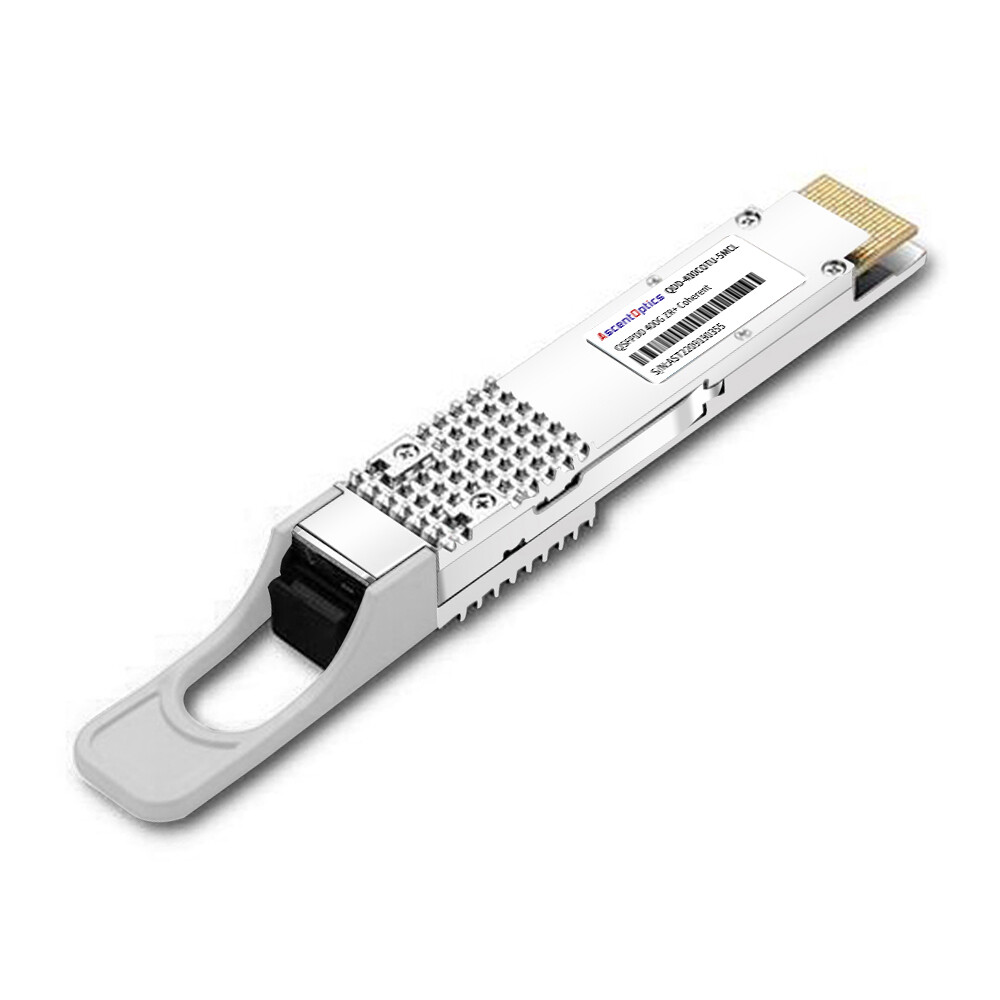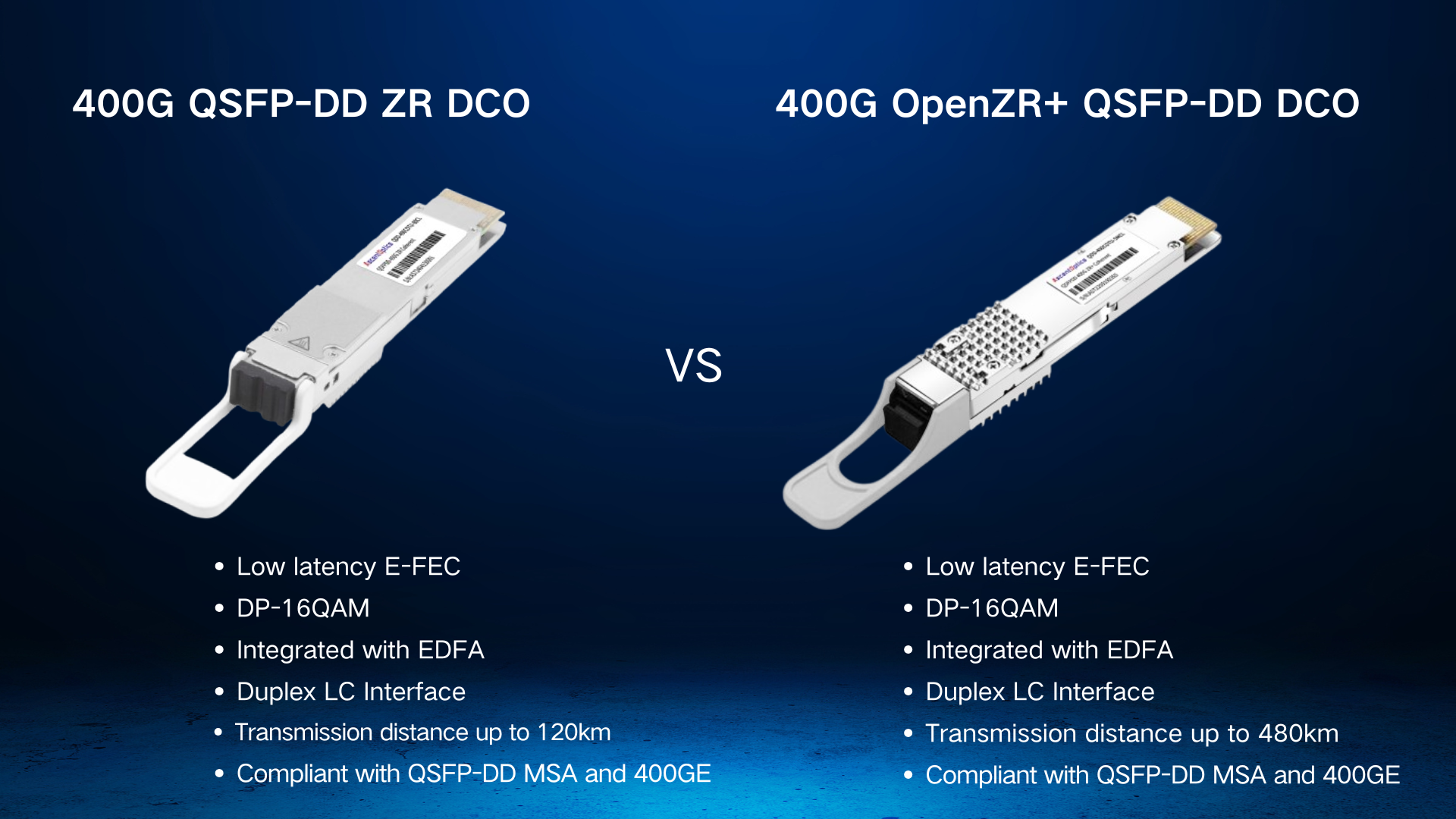With the rapid growth of data center traffic and the increasing demands of cloud computing and AI applications, networks now require higher speed, lower latency, and longer transmission distances. Traditional optical transceivers can no longer keep up with these needs. The 400G QSFP-DD ZR DCO transceiver was developed to meet these challenges. It combines 400G bandwidth, coherent transmission, and a standard QSFP-DD form factor. This makes it an ideal solution for data center interconnects (DCI) and metro network applications.
This article provides a comprehensive introduction to the module’s key technologies, core advantages, and application value, helping you better understand and deploy next-generation high-performance optical networks.

The 400G QSFP-DD ZR DCO optical transceiver is a coherent module that supports 400Gbps data rates in a QSFP-DD form factor. It complies with the OIF 400ZR standard and supports both ZR and ZR+ specifications. It uses digital coherent optics (DCO), meaning it integrates a digital signal processor (DSP) and a tunable laser (ITLA).
This module supports transmission distances of up to 80 km over single-mode fiber, and some OpenZR+ versions can extend beyond 120 km. The built-in DSP enables advanced modulation and error correction. Its pluggable design greatly simplifies deployment and maintenance.
The 400G QSFP-DD ZR DCO module helps customers optimize network architecture and reduce costs in IP-over-DWDM and point-to-point, unamplified transmission scenarios. It also supports emerging ROADM line systems, playing an important role in metro and regional ROADM-based networks.
QSFP-DD (Quad Small Form-factor Pluggable Double Density) is one of the leading high-speed, high-density optical module formats. It offers a compact size while supporting high channel density. It is backward compatible with QSFP28 and QSFP56, making it easy to upgrade to 400G networks without changing existing infrastructure.
The ZR series standards are defined by the OIF (Optical Internetworking Forum) to standardize point-to-point coherent optical links between data centers. Compared to traditional coherent transport systems, ZR modules offer lower cost, lower power consumption, and easier, standardized deployment.
400ZR: Supports transmission distances up to 80 km, ideal for DCI and metro applications.
OpenZR+: Supports longer distances (up to 120 km or more) and offers flexible client signal mapping, making it suitable for more complex use cases.
DCO modules integrate a digital signal processor (DSP) that enables advanced modulation formats such as 16QAM. These modules deliver high noise tolerance and low bit error rates, making high-speed 400G transmission over 80–120 km possible without optical amplification or regeneration.

Both the 400G OpenZR+ QSFP-DD DCO and 400G ZR QSFP-DD DCO are optical modules designed for long-haul transmission. They are based on digital coherent optics (DCO), use the QSFP-DD form factor, and support 400G data rates. The main differences lie in standards, target applications, technical features (especially modulation and FEC), and interoperability.
The 400G ZR module is defined by the OIF (Optical Internetworking Forum) as a formal industry standard. It focuses on point-to-point coherent links between data centers. It offers a high degree of standardization and interoperability.
The 400G OpenZR+ module is an open extension proposed by multiple leading vendors, including Microsoft, Cisco, and Inphi. Based on the 400ZR specification, it adds more flexible features to meet the needs of metro and carrier networks with more complex requirements.
The 400G ZR module is designed for point-to-point links up to 80 km, typically without amplification, making it ideal for direct data center interconnects (DCI).
The OpenZR+ module supports longer distances, typically up to 120 km or even 400 km. Some versions can be used with optical amplifiers and ROADM systems, making them suitable for broader metro and regional network deployments.
OpenZR+ offers more advanced features, such as:
In contrast, the 400G ZR module is more fixed-function. It mainly supports 400GE only, does not support wavelength tuning, and is not designed for complex DWDM systems.
ZR modules can be directly plugged into switches or routers that support the 400ZR protocol. They offer simple deployment, low power consumption, and do not require complex supporting equipment.
OpenZR+ modules, on the other hand, require network devices that support coherent reception and flexible configuration. They may also need to be used in conjunction with amplifiers or ROADMs, resulting in slightly higher deployment complexity—but with the benefit of greater network adaptability and scalability.

The 400G QSFP-DD ZR DCO optical transceiver is a high-performance solution designed for long-haul data center interconnect (DCI) and metro network applications. It supports transmission distances of 80 to 120 km, with direct transmission up to 40 km and extended reach via optical amplifiers. Leveraging DP-16QAM modulation, coherent detection, and a 7nm DSP, it delivers high sensitivity (as low as -20 dBm) while compensating for chromatic and polarization mode dispersion without requiring external modules—greatly simplifying network architecture.
The module adopts a compact QSFP-DD form factor (18.4mm × 93.4mm × 8.5mm), enabling up to 36 ports per 1U switch—four times the density of CFP2 modules. It also boasts ultra-low power consumption, typically under 15W, complying with OIF 400ZR standards. This makes it ideal for high-density deployment, offering over 50% power savings compared to legacy coherent systems.
Built on open standards like OIF 400ZR, QSFP-DD MSA, and OpenZR+, the module ensures seamless interoperability across multi-vendor environments. It can be directly integrated into routers or switches via QSFP-DD ports, supporting IP over DWDM without requiring separate transport equipment—driving significant CAPEX and OPEX savings.
Offering exceptional flexibility, the transceiver supports tunable modulation formats ranging from 100G DP-QPSK to 400G DP-16QAM, making it adaptable for various bandwidth and distance requirements. It also features C-band tunable wavelengths (191.3–196.1 THz), enabling full compatibility with DWDM systems. Multi-protocol support—including Ethernet and OTN—ensures the module fits diverse deployment scenarios such as DCI, 5G transport, and cloud backbone networks.
Operational simplicity and reliability are also key strengths. The module supports digital diagnostics monitoring (DDM) for real-time telemetry on optical power, temperature, and bias current, and is managed via CMIS. With integrated silicon photonics (e.g., TROSA) and industrial-grade components, it delivers outstanding reliability with MTBF exceeding 100,000 hours.
Lastly, the pluggable design allows it to replace traditional fixed-line coherent solutions, significantly reducing deployment and upgrade costs. By supporting multiple wavelengths over a single fiber through DWDM, it also improves fiber utilization and minimizes fiber infrastructure needs—delivering both performance and cost advantages for next-generation optical networks.
The 400G QSFP-DD ZR DCO optical module, with its high performance, low power consumption, and flexible compatibility, is widely used in the following scenarios:
In Data Center Interconnect (DCI) scenarios, the 400G QSFP-DD ZR DCO optical module is widely used to connect different data centers or various clusters within a data center—such as spine-to-leaf connectivity in a leaf-spine architecture. It supports long-distance transmission ranging from 80 to 120 km, making it ideal for regional and metro-scale interconnection.
Key advantages include:
In metropolitan and regional backbone networks, the 400G QSFP-DD ZR DCO optical module is ideal for carrying traffic at the core layer of MANs or across regional backbones. It is commonly used to connect data centers, base stations, or aggregation nodes within a city.
Key advantages include:
In 5G transport networks, the 400G QSFP-DD ZR DCO optical module is used to connect 5G core networks, base stations (BBU/RRU), and fronthaul/midhaul nodes, meeting the high bandwidth and low latency demands of 5G infrastructure.
Key advantages include:
The 400G QSFP-DD ZR DCO optical module is also well-suited for enterprise and campus network expansion, enabling high-speed connectivity between corporate headquarters and branch offices, multi-campus interconnection, or large-scale campus environments with high bandwidth demands.
Key advantages include:
The 400G QSFP-DD ZR DCO optical module is well-suited for intra-connectivity within hyperscale data centers operated by major cloud service providers such as AWS, Azure, and Alibaba Cloud. It supports high-throughput applications like AI training, big data analytics, and large-scale distributed computing.
Key advantages include:
Data Center Interconnect: Use QSFP-DD ZR DCO modules to connect two 400G-capable switches—such as Cisco Nexus 9000 or Juniper PTX—achieving relay-free transmission over distances up to 80 km.
5G Fronthaul: Connect the QSFP-DD ZR DCO module to multiple 25G/50G base stations via breakout fiber cables (e.g., MPO-12 to 8×LC), enabling multi-service aggregation in 5G networks.
The 400G QSFP-DD ZR DCO optical module offers a highly integrated, low-power, and easy-to-deploy solution for long-reach coherent transmission across data center and carrier networks. By meeting the growing demand for high data throughput while reducing network complexity and operational costs, it serves as a key enabler in the evolution from traditional to modern optical infrastructure.
In summary, the 400G QSFP-DD ZR DCO module is an ideal choice for next-generation data center interconnects and long-haul transmission. Combining high speed, long reach, low power consumption, and simplified deployment, it plays a crucial role in advancing optical network development.